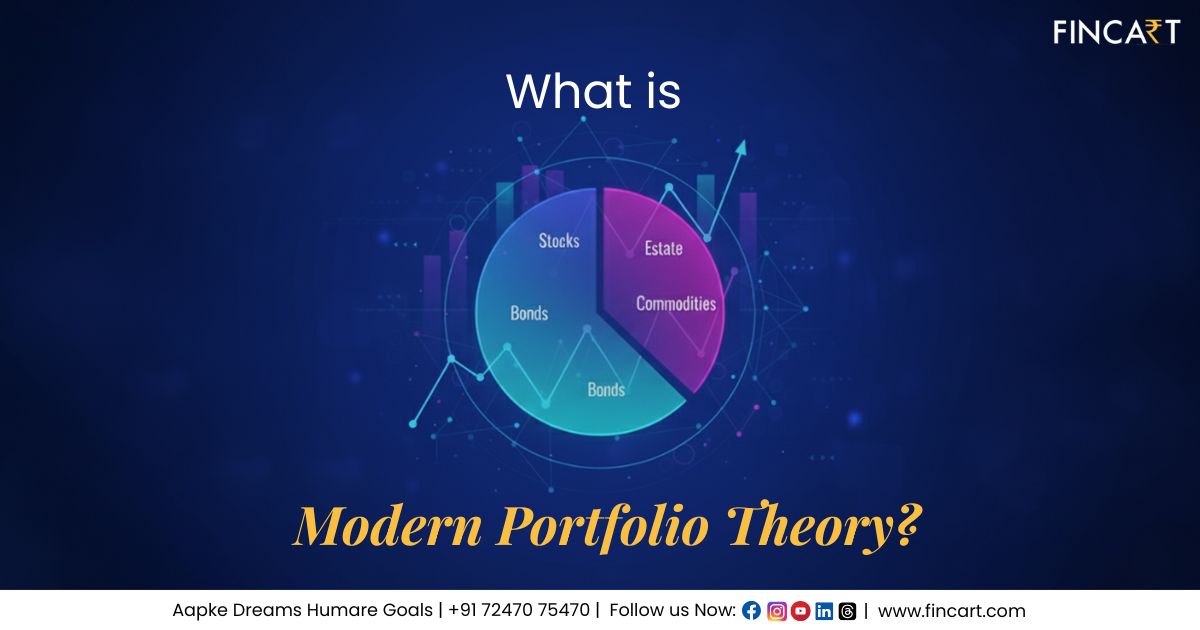When it comes to building long-term wealth, one principle remains timeless: don’t put all your eggs in one basket. This simple idea lies at the heart of Modern Portfolio Theory (MPT)—a groundbreaking concept that changed the way investors approach risk, returns, and portfolio construction.
Whether you are investing through portfolio management services (PMS investment), mutual funds, or other investment services, understanding MPT can help you make smarter decisions aligned with your goals and risk tolerance.
In this blog, we’ll explore:
- The origins of Modern Portfolio Theory
- Key concepts like diversification, risk, and the efficient frontier
- Practical applications for individual investors
- Criticisms and limitations
- How MPT shapes professional portfolio management services today
The Origins of Modern Portfolio Theory
Modern Portfolio Theory was introduced by Harry Markowitz in 1952 in his paper “Portfolio Selection” published in The Journal of Finance. For his revolutionary work, he was later awarded the Nobel Prize in Economics in 1990.
Before MPT, most investors focused on individual stocks or assets, often chasing returns without properly accounting for the risks. Markowitz shifted the perspective: instead of looking at investments in isolation, he emphasized analyzing how different assets interact with each other in a portfolio.
In short: It’s not about finding the perfect stock—it’s about building the right mix of assets.
What is Modern Portfolio Theory?
At its core, Modern Portfolio Theory (MPT) helps investors design a portfolio that either:
- Maximizes returns for a given level of risk, or
- Minimizes risk for a given level of expected return.
Instead of focusing on single investments, MPT emphasizes how different assets work together in a portfolio.
It’s built on two fundamental pillars:
1. Diversification
Diversification means spreading your investments across multiple assets to reduce risk. By holding a mix of equities, bonds, gold, and even alternative investments, you avoid the danger of a single event wiping out your wealth.
Example:
Between 2001–2020, the S&P 500 (U.S. equities) delivered an average annual return of ~7.5%. But in years like 2008, it lost nearly -37%.
In contrast, U.S. Treasury bonds returned around 4–5% annually during the same period, and in 2008 they were actually positive.
- If you held only equities, your portfolio would’ve suffered massive losses.
- If you diversified across equities + bonds, the bond returns would have cushioned the fall
That’s the power of diversification—reducing the swings (volatility) in your portfolio.
2. Efficient Frontier
The efficient frontier is a curve that shows the best possible trade-off between risk and return. Any portfolio on this frontier offers the maximum return for its level of risk.
Imagine two investors:
- Investor A: invests 100% in equities. Potential return: 12%, but risk (volatility): 20%.
- Investor B: invests 60% in equities + 40% in bonds. Potential return: 9%, but risk: only 12%.
Investor B is closer to the efficient frontier—slightly lower returns, but significantly lower risk. Over the long term, such balanced portfolios usually create more consistent wealth.
In short: Markowitz’s theory gave investors a scientific framework for decision-making—shifting investing from gut feeling to data-driven allocation. It proved that diversification is not just common sense, but mathematically beneficial.
Key Concepts of Modern Portfolio Theory
1. Risk and Return
Every investment carries two components:
- Expected Return – the profit you hope to make.
- Risk – the possibility that the actual return will differ from the expected return.
MPT defines risk as the standard deviation of returns—essentially the volatility of an investment. Higher volatility means higher risk.
2. Diversification
“Don’t put all your eggs in one basket” is the golden rule here. By spreading investments across asset classes—stocks, bonds, gold, real estate, and even alternative assets—you reduce the impact of one poorly performing investment on your overall portfolio.
Example:
Imagine you invest only in airline stocks. If fuel prices rise, the whole sector could suffer, hurting your portfolio. But if you diversify across airlines, IT companies, pharma stocks, and government bonds, the negative impact of one sector is cushioned by the stability or growth of others.
3. Correlation of Assets
MPT emphasizes combining assets that are not perfectly correlated. If two assets move differently under the same market conditions, their combination reduces overall portfolio risk.
Example:
- Stocks and government bonds often have a negative or low correlation.
- When stock markets fall during economic downturns, bonds often perform better, balancing the portfolio.
4. The Efficient Frontier
The efficient frontier is a curve that represents portfolios offering the highest possible return for each level of risk. Any portfolio below the curve is inefficient (too much risk for too little return).
An investor should aim to position their portfolio on this curve.
Visual Example:
Imagine plotting risk on the X-axis and return on the Y-axis. Portfolios on the efficient frontier line are “ideal” because they maximize returns for the chosen risk level.
5. The Capital Market Line (CML)
When a risk-free asset (like government securities) is combined with a diversified portfolio of risky assets, we get the Capital Market Line. The tangent point where this line touches the efficient frontier represents the optimal portfolio.
Application of Modern Portfolio Theory in Real Life
While MPT sounds technical, its lessons are highly practical for investors at all levels.
For Individual Investors
- If you’re young, you might have a higher risk tolerance. According to MPT, you can allocate more to equities for long-term growth.
- If you’re closer to retirement, your portfolio should lean more towards bonds and stable instruments to preserve wealth.
Example Allocation:
- Aggressive investor (age 30): 70% equities, 20% bonds, 10% alternatives.
- Conservative investor (age 55): 40% equities, 50% bonds, 10% gold.
For Professional Portfolio Management Services
Portfolio management services (PMS investment) directly apply MPT principles. Wealth managers analyze your risk appetite, investment goals, and time horizon to design a customized portfolio.
For instance:
- If you want steady income, the PMS may tilt your allocation toward debt and dividend-paying stocks.
- If you’re seeking aggressive growth, they may design a portfolio heavy on equities and emerging market funds.
This structured approach is exactly what sets professional investment services apart—they don’t just pick stocks; they build a diversified, optimized portfolio that aligns with your objectives.
Criticisms and Limitations of Modern Portfolio Theory
No theory is perfect, and MPT has its critics:
- Assumption of Normal Distribution:
MPT assumes returns follow a bell curve, but real markets often show extreme events (e.g., 2008 crisis). - Correlation Isn’t Constant:
The theory assumes correlations between assets remain steady. But in crises, correlations can spike, reducing the benefits of diversification. - Risk Definition:
Standard deviation treats both positive and negative surprises as “risk.” But in reality, most investors welcome higher-than-expected returns!
Despite these limitations, MPT remains a cornerstone of portfolio management. In fact, it has inspired other critical financial theories like the Capital Asset Pricing Model (CAPM) and the Efficient Market Hypothesis (EMH).
Why Modern Portfolio Theory Matters for You
Whether you’re managing your own savings or relying on professional investment services, MPT gives you timeless takeaways:
- Diversify, always. Spread your money across asset classes, industries, and geographies.
- Match risk with goals. A college fund or retirement plan requires different portfolios than short-term trading.
- Review and rebalance. Periodically sell overweighted assets and buy underweighted ones to stay aligned with your goals.
- Adapt with age. Risk tolerance changes over time—your portfolio should reflect that.
The Role of Portfolio Management Services
For many investors, applying MPT on their own can be complex. That’s where portfolio management services (PMS investment) play a crucial role.
Professional PMS providers like Fincart:
- Assess your financial goals and risk appetite
- Apply Modern Portfolio Theory to design a personalized, diversified portfolio
- Continuously monitor, rebalance, and adapt investments
- Offer access to a wider range of asset classes and strategies than individual investors might achieve alone
By leveraging MPT in their framework, PMS ensures you get the best risk-adjusted returns, not just high returns.
The Bottom Line
Modern Portfolio Theory changed the landscape of investing forever. By shifting the focus from chasing individual stocks to constructing diversified portfolios, Harry Markowitz laid the foundation for today’s professional investment services and PMS investments.
The core lesson remains as relevant as ever: maximize returns while keeping risk within your comfort zone.
For investors, the smartest move is to adapt these principles through disciplined investing or by partnering with trusted portfolio management services. Whether your goal is wealth creation, retirement planning, or financial independence, MPT provides a framework to build a future that balances both growth and security.




